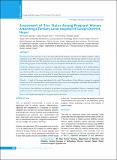Please use this identifier to cite or link to this item:
https://hdl.handle.net/20.500.14356/1348Full metadata record
| DC Field | Value | Language |
|---|---|---|
| dc.contributor.author | Tamang, Man Kumar | - |
| dc.contributor.author | Yadav, Uday Narayan | - |
| dc.contributor.author | Acharya, Anish | - |
| dc.contributor.author | Lamsal, Madhab | - |
| dc.date.accessioned | 2023-05-08T07:49:42Z | - |
| dc.date.available | 2023-05-08T07:49:42Z | - |
| dc.date.issued | 2019 | - |
| dc.identifier.citation | TamangM. K., YadavU. N., AcharyaA., & LamsalM. (2020). Assessment of Zinc Status Among Pregnant Women Attending a Tertiary Level Hospital of Sunsari District, Nepal. Journal of Nepal Health Research Council, 17(4), 468-473. https://doi.org/10.33314/jnhrc.v17i4.2065 | en_US |
| dc.identifier.issn | Print ISSN: 1727-5482; Online ISSN: 1999-6217 | - |
| dc.identifier.uri | http://103.69.126.140:8080/handle/20.500.14356/1348 | - |
| dc.description | Original Article | en_US |
| dc.description.abstract | Abstract Background: Zinc deficiency is one of the major public health problems especially in developing countries, with an estimation of over 80% of pregnant women to be zinc deficient worldwide. Maternal zinc deficiency elevates the risk of foetal growth restriction. This study aimed to assess zinc deficiency and to examine the factors associated with zinc status among pregnant women attending a tertiary level hospital in Sunsari district, province no. one, Nepal. Methods: Pregnant women were selected by using time frame consecutive sampling at B. P. Koirala Institute of Health Sciences, Dharan from September to November 2018. Data on nutritional, socio-demographic and reproductive profiles were collected using a semi-structured questionnaire. Blood was collected from each pregnant woman to estimate serum zinc concentration by atomic absorption spectrophotometry. Association between serum zinc concentration and predictor variables were assessed using chi-square test. Results: A total of 156 women participated in the study. The prevalence of zinc deficiency among the pregnant women was 22.6%. Our data did not show association of any of the socio-demographic, nutritional and reproductive variables with serum zinc status (p-value>0.05) in chi-square. Conclusions: Zinc deficiency was found to be prevalent in our targeted population. However, community based studies need to be conducted for exploring more precise relationship between zinc status and other variables. Keywords: Nepal; nutritional factors; pregnant women; zinc status. | en_US |
| dc.language.iso | en | en_US |
| dc.publisher | Nepal Health Research Council | en_US |
| dc.relation.ispartofseries | Oct-Dec, 2019;2065 | - |
| dc.subject | Nepal | en_US |
| dc.subject | Nutritional factors | en_US |
| dc.subject | Pregnant women | en_US |
| dc.subject | Zinc status | en_US |
| dc.title | Assessment of Zinc Status Among Pregnant Women Attending a Tertiary Level Hospital of Sunsari District, Nepal | en_US |
| dc.type | Journal Article | en_US |
| local.journal.category | Original Article | - |
| Appears in Collections: | Vol. 17 No. 4 Issue 45 Oct-Dec 2019 | |
Files in This Item:
| File | Description | Size | Format | |
|---|---|---|---|---|
| 2065-Manuscript-13230-1-10-20200121.pdf | Fulltext Download | 720.39 kB | Adobe PDF |  View/Open |
Items in DSpace are protected by copyright, with all rights reserved, unless otherwise indicated.
